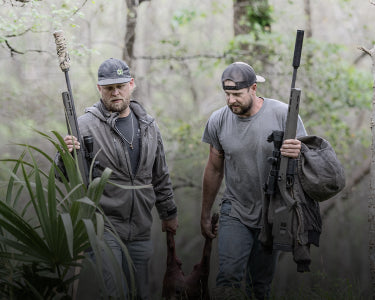Whether you’re hog hunting with a bow or rifle, effective shot placement comes down to a hog’s body position at the time of impact—most often the position the pig was standing in at the time of the shot.
Of course, the flight time of a bullet or arrow may allow for slight point-of-impact changes and usually not for the better. To that end, make sure you’re shooting within your level of confidence.
Note that many of these shot-placement rules also apply to big game, whether you’re hunting on public land or private land.
Essential Hog Hunting Gear: Bow and Rifle Setup
Equally as important as shot placement is ammo—for bowhunters, this equates to arrow and broadhead setups and honestly, your bow setup as a whole. For bowhunting, I am currently shooting Carbon Express Maxima Red 350 arrows tipped with either 100-grain Zeus Broadheads (fixed/hybrid) or 100-grain Xecutioner Xpandables (mechanicals.)
I trust both in terms of razor-sharp blades, function on impact, large cutting diameters and field-point type flight. They have yet to let me down, and the number of hogs I’ve harvested is proof-positive of that!

Top Rifle Calibers for Hog Hunting
I have killed countless hogs in the United States with both bolt-action rifles and gas-operated, semi-auto AR-platform modern sporting rifles. I enjoy hunting with each equally but for different reasons, whether I’m after a single monster from far off or enjoy the challenge of manual bolt-cycling for follow-up shots, or I’m simply making as much bacon as possible out of any number of corn-thieves I run into. Either way, the caliber of bullets I choose have similarities.
With respect to rifles, I’ll break down my personal favorite caliber choices for hog hunting into three different rifle platforms—bolt-action, AR-10 and AR-15. Caliber choice is also subjective and this shortlist is clearly not all-inclusive. The point being, if you prefer another caliber, use it.
Best Hog Hunting Calibers for Bolt-Action Rifles
- .308 Winchester
- 6.5 Creedmoor
- 6.5 PRC
Recommended AR-15 Calibers for Hog Hunting
- 6.5 Grendel
- 6.8 SPC
- Sharps Rifle Company .25-45
- .224 Valkyrie
- Winchester’s .350 Legend
- Wilson Combat’s .300 HAM’R
AR-10 Caliber Picks for Hog Hunting
- .308 Winchester
- 6.5 Creedmoor
Worth mentioning, .22- and .28-Nosler, .450 BM, .458 SOCOM and .500 Beowulf also are picking up steam here in Texas. As a final note, yes, .223/5.56 are still popular but I prefer cartridges offering some combination of larger case capacity, higher velocity or a larger, heavier bullet.
Hybrid AR-15/AR-10 Options for Big Boars
A solid hybrid AR-15/AR-10 choice creating buzz is Wilson Combat’s .458 HAM’R. This big-bore cartridge designed for AR systems is another sure-fire nightmare for hogs. The hybrid nature of the .458 HAM’R requires a Wilson Combat receiver set, BCG and barrel.

Best Optics for Hog Hunting Day or Night
Optics are critically important for proper shot placement. My archery optic setup is great for daytime shooting but specifically designed to facilitate successful shooting when I bow hunt most often—at night.
Rifle-mounted optics also should be purpose-driven based on distance, day or night shooting, etc. For daytime optics at longer ranges, I prefer traditional riflescopes, even first-focal-plane if my environment can accommodate increased magnification.
For close- to mid-range shooting, I prefer red dot optics, more traditional second-focal-plane riflescopes (like the Sightmark Core TX MR 4-16x44mm) or I simply jump straight to thermal imaging. For night hunting, I certainly prefer a thermal riflescope, although, depending on weather, sometimes digital night vision is a wiser choice. Either way, let purpose determine your optic.

Broadside Shot Placement on Wild Hogs
For broadside shots within your comfort zone, the best shot to stop wild pigs in their tracks is just behind the ear—the earhole also makes a great point of aim. A shot in this area penetrates the brain—lights out, instantly.
If you’re not comfortable with ear-shots or you’re shooting a bow, shooting directly at the back crease of the front shoulder, no more than mid-line of the hog’s body height, preferably one-third up from the bottom edge of the body gives you a great opportunity at lungs.
Lower on the same crease, just a couple inches above the lower body line, in what I refer to as the armpit area of the hog, is the heart; of course, heart- and lung-shot hogs can still run. Be prepared to track blood depending on your environment.
For a rifle hunter electing to take a broadside body-shot, shooting through the shoulder is also quite effective. When a hog is standing at true-broadside, not angled toward or away from the shooter, this shot generally results breaking both shoulders and destroying either the lungs or the heart. Broken shoulders obviously make running away tough at best, and blood-tracking a cinch. Seasoned hog hunters often quip, “Pin the shoulders together and they won’t go far.”

How to Take Front-Facing Shots on Hogs
If you intend to shoot a pig facing you, aim at the center of the forehead just above the centerline of the eyes to penetrate the skull and brain, or at the center of the chest, although this point-of-aim is often obscured by the hog’s snout and jaw. Bowhunters should not attempt either of these shots.
Rifle hunters should wait until the feral hog’s head either exposes the chest or, for a head-shot, is at a natural forward-facing position (looking in your direction), not looking up, down or to the side. These head positions can result in missing the brain or even deflection, especially with respect to large boars and sows.
Shot Placement on Quartered-To Hogs
For bowhunters, shots on pigs quartered toward the shooter are risky—a fair amount of bone from the sternum, ribs and closest shoulder make the shot difficult; thus, in my opinion, should not be taken. Rifle hunters have an easier time penetrating vitals than bowhunters.
For a “quartered-to” shot, aim to the inside of the closest front shoulder, between the shoulder and vertical midline of the chest—the amount of shift for good shot placement can change depending on the hog’s degree of angle toward you; however, determining the angled point-of-entry required to penetrate organs should be easy. If you cannot make such a determination, wait for another shot within your level of confidence.
Quartered-Away Hog Hunting Shots
Determining point-of-aim while hog hunting in a quartered-away position is easier and more desirable, especially as it relates to bowhunters and the big boys. Large boars generally have a ridiculously tough, often thick, shield covering the front shoulders and sweeping back over the vitals.
A quartered-away shot from a bow allows the bowhunter to slip behind the shield for much deeper penetrating shots. For lower-poundage bowhunters engaging large hogs, this shot may be the only reasonable choice for an effective kill.

Rifle hunters using appropriate hunting ammo should not have issues with penetrating a hog’s shoulder or shield, making quartered-away and broadside shots perfect opportunities for easy shot placement. For quartered-away shots, aim for the front edge of the opposite forward shoulder.
As your point of aim relates to broadside shooting, keep shots no higher than mid-way up the hog’s body, preferably at one-third for a solid lung shot or just a couple inches up from the bottom edge of the body profile, in the “armpit” area for a heart-shot—again, expect the hog to run a short distance—even up to 100 yards. The only dead-in-its-tracks, anchoring shots I see are brain and spine shots; however, the latter often requires follow-up shots—definitely not ideal.
As a final note on quartered-away animals, the greater the degree the animal is facing away, the more apt a shooter is to lose the aiming reference of the front edge of that forward shoulder. In addition, as the angle increases, the potential for making a double-lung shot decreases, allowing a shot hog to run further.
Do you bow or rifle hunt? Maybe you do both! What do you think about shot placement? Tell us in the comment section.
Here is the complete, copy-pasteable HTML block including the styled FAQ section followed by its corresponding JSON-LD schema:Frequently Asked Questions
Where is the best place to shoot a hog for an instant kill?
The best shot for an instant kill is just behind the ear, aiming for the brain. A direct hit to this area drops the hog immediately.
What are the best broadheads for hog hunting?
Broadheads like the 100-grain Zeus Broadheads and Xecutioner Xpandables are excellent choices due to their sharpness, cutting diameter, and flight consistency.
What calibers are best for hog hunting with bolt-action rifles?
Popular bolt-action calibers for hog hunting include .308 Winchester, 6.5 Creedmoor, and 6.5 PRC.
What AR-15 calibers work well for hog hunting?
Effective AR-15 hog calibers include 6.5 Grendel, 6.8 SPC, .25-45 Sharps, .224 Valkyrie, .350 Legend, and .300 HAM’R.
What’s the difference between the 'S' and non-'S' models of the Photon RT?
The non-'S' models use a covert 940nm IR illuminator for stealth, which does not emit a visible red glow, making them ideal for stealth night hunting.
Can I use the Photon RT during the day?
Yes, the Photon RT is designed for both day and night use, offering versatile performance in all lighting conditions.
Is a quartered-away shot good for bowhunters?
Yes, quartered-away shots allow bowhunters to avoid the hog’s thick shoulder shield and hit vital organs with better penetration.
Should bowhunters take front-facing shots on hogs?
No, front-facing shots are not recommended for bowhunters due to bone obstructions and poor penetration angles.
What is the Sightmark Wraith good for?
The Wraith is a digital night vision optic ideal for detecting hogs out to 200 yards, making it perfect for nighttime hunting.
How important is shot placement when hog hunting?
Shot placement is critical—poor placement can lead to long tracking jobs or wounded animals. Aim based on the hog’s position and your confidence level.




